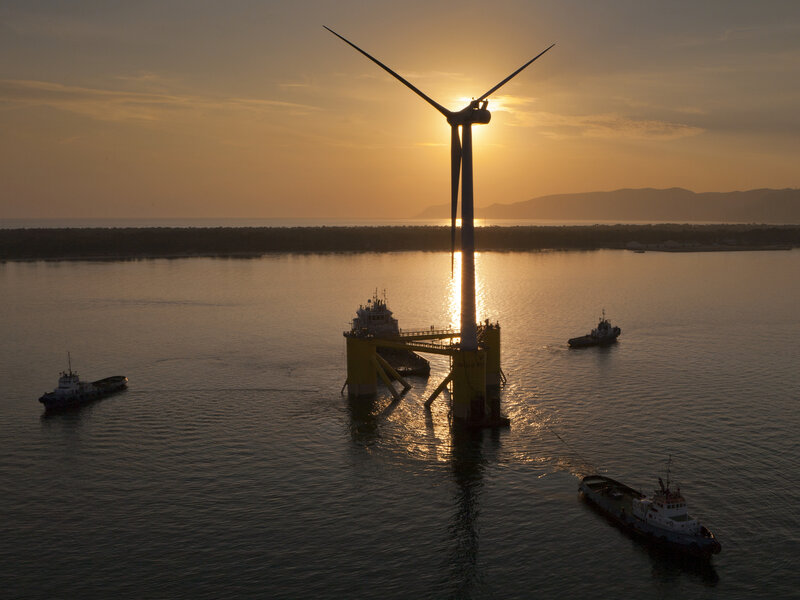How Portugal went 107 hours on only renewable energy
Loading...
From the morning of May 7 to the afternoon of May 11, Portugal's electricity consumption was fully covered by renewable sources.
For 107 hours, Portugal powered all of its electricity from biofuels, hydropower plants, wind turbines, solar panels, and geothermal heat. But this is not the first time that Portugal has boasted an impressive energy statistic.
For a few hours at the end of 2011, all of the country's electricity demands were met by renewable energy. The country's annual renewable energy consumption has grown in recent years. In 2013, Portugal got almost 26 percent of its electricity from renewables, rising to 63 percent in 2014. But because of a drought, Portugal's source of renewable electricity decreased to 50.4 percent in 2015.
The country's energy example has won praise from the International Energy Agency (IEA), whose 2016 review of Portugal says its policies have "been strongly oriented towards its ambition to become a major player in the application of renewable energies, especially in sectors such as wind power.... Portugal should be commended for its achievements and its ambitions in large-scale deployment of renewable energy."
Portugal generates 30 percent of its electricity from hydropower, about one quarter from wind, 6.4 percent from biofuels and waste, and 1.2 percent from solar. Wind energy production grew by more that 600 percent between 2004 and 2009, and in 2014, Portugal was second only to Denmark in wind power.
"How did Portugal assume such impressive leadership in the clean energy transition?" asks WorldWatch Institute. "The key, as usual, lies in ambitious supportive policies."
Feed-in tariffs, which provide renewable electricity producers with a guaranteed price for each megawatt-hour of energy fed into the country's power grid, were first introduced in 1988 and have continued to develop, according to WorldWatch. Also, host municipalities of renewable energy receive payments of 2.5 percent of revenue. And the government bought transmission lines from private power companies at the turn of the century, refitting the grid infrastructure to better connect with small electricity generators such as domestic solar panels.
Of course, Portugal's bold renewable energy initiative would not be possible everywhere. As of 2015, the country had a population of about 10.8 million, whereas the US is home to nearly 320 million. Geographically, the country is about the size of Maine.
But in comparison to other countries in the European Union, who are more similar to Portugal in terms of population and geographical size, Portugal's renewable energy initiatives are still impressive.
Financially, Portugal falls behind the pack, with a GDP per capita of $27,800 in 2015: up to 30 percent below the EU-28 average, along with Greece, Slovakia, Estonia, and Lithuania. About one in five Portuguese citizens reported struggling to pay for food at least once in the previous year, according to a 2013 Gallup poll. But despite economic hardship, Portugal leads its EU counterparts in renewable energy.
The 28 countries in the EU generated an average of 27.5 percent of its electricity from renewable energy in 2014, according to Eurostat. But in Portugal, this percentage of renewable sources is more than 20 points higher at 52.1 percent – only behind Austria, Sweden, Iceland, and Norway.
And in overall energy consumption, the EU averaged 16 percent of energy from renewable sources, in line of its 20 percent goal by 2020. Again, Portugal beat the average, with 27 percent of its overall consumption coming from renewables in 2014. By 2020, Portugal hopes to have renewables fuel 31 percent of overall consumption – above the EU goal.
But it has not been all smooth sailing with Portugal's renewable efforts: The country has been left with a substantial electricity tariff deficit. Because the tariffs charged to consumers were set below the total costs for the electricity system borne by energy companies, a deficit accumulated up to €4.69 billion, or $5.31 billion, by 2014.
"In recent years, falling demand, rising subsidies to renewable energy and legacy support to thermal electricity generation led to increasing electricity costs and, as a result, growth in the tariff debt," explains IEA. But through a package of measures, Portugal plans to eliminate the tariff debt by 2020 and ensure its electricity system is sustainable.








